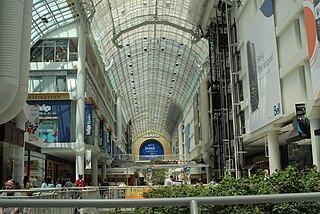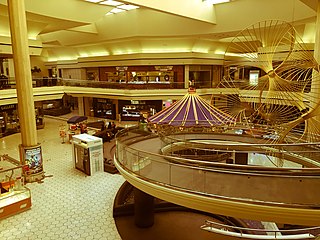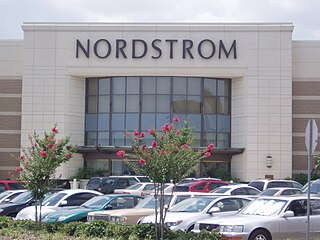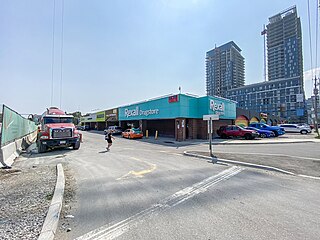
Brownfield is land that is abandoned or underutilized due to pollution from industrial use. The specific definition of brownfield land varies and is decided by policy makers and/or land developers within different countries. The main difference in definitions of whether a piece of land is considered a brownfield or not depends on the presence or absence of pollution. Overall, brownfield land is a site previously developed for industrial or commercial purposes and thus requires further development before reuse.

A shopping mall is a large indoor shopping center, usually anchored by department stores. The term mall originally meant a pedestrian promenade with shops along it, but in the late 1960s, it began to be used as a generic term for the large enclosed shopping centers that were becoming increasingly commonplace. In the United Kingdom and other countries, shopping malls may be called shopping centers.

A shopping center, shopping centre, also called a shopping complex, shopping arcade, shopping plaza or galleria, is a group of shops built together, sometimes under one roof.

Greenfield land is a British English term referring to undeveloped land in an urban or rural area either used for agriculture or landscape design, or left to evolve naturally. These areas of land are usually agricultural or amenity properties being considered for urban development.

A dead mall is a shopping mall with a high vacancy rate or a low consumer traffic level, or that is deteriorating in some manner.

The Shops at Hilltop, formerly known as Hilltop Mall, was a regional shopping center in the Hilltop neighborhood of Richmond, California. Hilltop was managed and co-owned by Prologis, Inc. The only anchor store left is Walmart. There are 3 vacant anchor stores that were once Macy's, JCPenney and Sears.

Columbus City Center was a 1,250,000 sq ft (116,000 m2), three-level shopping mall in Columbus, Ohio. It was located in the city's downtown, near the Ohio Statehouse, next to the Ohio Theatre, and connected to the Hyatt on Capitol Square hotel. The mall's closed and was demolished in 2009. The mall had a large adjacent parking structure attached that remains in use. The parking structure has been joined, directly or via bridge respectively, to two 12 story structures, 250 S. High Street and 80 on the Commons, both of which feature lower level office spaces with residential spaces on the upper floors.

In urban planning, infill, or in-fill, is the rededication of land in an urban environment, usually open-space, to new construction. Infill also applies, within an urban polity, to construction on any undeveloped land that is not on the urban margin. The slightly broader term "land recycling" is sometimes used instead. Infill has been promoted as an economical use of existing infrastructure and a remedy for urban sprawl. Detractors view increased urban density as overloading urban services, including increased traffic congestion and pollution, and decreasing urban green-space. Many also dislike it for social and historical reasons, partly due to its unproven effects and its similarity with gentrification.

In US retail, an "anchor tenant", sometimes called an "anchor store", "draw tenant", or "key tenant", is a considerably larger tenant in a shopping mall, often a department store or retail chain. They are typically located at the ends of malls, sometimes in the middle. With their broad appeal, they are intended to attract a significant cross-section of the shopping public to the center. They are often offered steep discounts on rent in exchange for signing long-term leases in order to provide steady cash flows for the mall owners. Some examples of anchor stores in the United States are: Macy's, Sears, JCPenney, Nordstrom, Neiman Marcus, Saks Fifth Avenue, Dillard's, Kohl's, and Target. And in Canada; Hudson's Bay, Sears (formerly), Target (formerly), Zellers, Nordstrom/Nordstrom Rack (formerly), TJX Companies, Saks Fifth Avenue, Sporting Life.

Mixed use is a type of urban development, urban design, urban planning and/or a zoning classification that blends multiple uses, such as residential, commercial, cultural, institutional, or entertainment, into one space, where those functions are to some degree physically and functionally integrated, and that provides pedestrian connections. Mixed-use development may be applied to a single building, a block or neighborhood, or in zoning policy across an entire city or other administrative unit. These projects may be completed by a private developer, (quasi-)governmental agency, or a combination thereof. A mixed-use development may be a new construction, reuse of an existing building or brownfield site, or a combination.

The Galleria Shopping Centre is a shopping centre in Toronto, Ontario, Canada. It is located at the southwest corner of the intersection of Dufferin and Dupont Streets. The mall is in the process of being redeveloped into a mixed-use development. As it is in process of being demolished, only half of the building remains.
Cooper Carry is a U.S.-based design firm providing architecture, planning, landscape architecture, interior design and environmental graphic design. The company is based in Atlanta with offices in Alexandria, Virginia; New York City; and.

One Bellevue Place is a regional shopping, dining, and entertainment complex in southwestern Nashville, Tennessee, specifically in the Bellevue neighborhood. Opened in 1990 as an enclosed regional shopping mall named Bellevue Center, it had capacity for over 90 stores on two floors totaling 848,545 square feet (78,832.4 m2). The mall itself opened in 1990, began showing signs of decline during the early 2000s recession, and closed in 2008. Two of its three anchor tenants continued to operate beyond the mall's closure, but both would eventually vacate the property as well. The entire structure, including the three adjacent anchor buildings and an outparcel, was demolished in 2015. A new mixed-use complex opened on the site in 2017.

Landmark Mall was an American shopping mall. Located in a triangle formed by Duke Street, Interstate 395, and Van Dorn Street in Alexandria, Virginia, the mall opened in 1965 and closed on January 31, 2017. The mall was anchored by Sears, Lord & Taylor and Macy's.

Land recycling is the reuse of abandoned, vacant, or underused properties for redevelopment or repurposing.

The Carousel Mall, also known as Central City Mall, was a mixed-use two-story shopping mall located in San Bernardino, California, along the city's former main downtown street.

CityCentre is a mixed-use development in the Memorial City district of Houston, Texas, located at the southeastern corner of the intersection of Interstate 10 and Beltway 8. Opened in 2009, CityCentre is a 50-acre (20-hectare) development with 2.1 million square feet (200,000 m2) of gross floor space, including 400,000 square feet (37,000 m2) of retail, restaurants and entertainment, a 149,000-square-foot (13,800 m2) fitness facility, 425,000 square feet (39,500 m2) of office space, and a variety of rental and non-rental residential developments. CityCentre has been recognized by the Urban Land Institute as a successful example of walkable, high-density development and progressive site planning in the United States.

Crestwood Court was a shopping mall in Crestwood, Missouri. Opened in 1957, it was the first major mall in the St. Louis area, and one of the first to have more than one department store. The mall previously included Macy's, Dillard's and Sears as anchor stores, all three of which were vacant for at least 5 years before demolition began in May, 2016, resulting in a "dead mall". Demolition was finished in October 2017. A Dierbergs opened at the site of the demolished mall in March of 2023. Decline was first noticeable in the early 2000s, but took off seriously in 2006, when many stores started to close their doors. The announcement the Dillard's would close in August 2007 was critical, because it was the most popular store. Two years later, Macy's closed, which was considered the ultimate dagger. It was by then assumed that Crestwood Mall was not going to be around much longer, and that became official in September 2013, when the exterior Lens Crafters closed their doors.

Agincourt Mall is a shopping mall in Toronto, Ontario, Canada. It is located at the northwest corner of Kennedy Road and Sheppard Avenue, in the Tam O'Shanter – Sullivan neighbourhood of northeastern Toronto. It is named for the adjacent historic village and current Toronto neighbourhood of Agincourt.

A power center or big-box center is a shopping center with typically 250,000 to 600,000 square feet of gross leasable area that usually contains three or more big box anchor tenants and various smaller retailers, where the anchors occupy 75–90% of the total area.



















